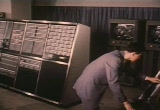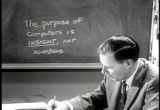Computers in Moving Pictures, Then and Now
 As part of a search for material for an animation for the local popular science festival, I went back looking out for videos and films usable for computing history. Returning, hopeful, to the on-line prelinger Internet Archive, three videos emerged out, one was On Guard! The Story of SAGE, a film commissioned by the IBM Military Products Division in 1956 and promoting the SAGE air defence system. The others were parts 1 and 2 of Logic by Machine: The Computer and the Mind of Man, a documentary by National Educational Television, dating back to the late 1950s-early 1960s expanding on how computing, especially the combination between high-speed programmable computing machines and intelligent thoughtful instruction devising was crucially to assist mankind's mastery of nature.
As part of a search for material for an animation for the local popular science festival, I went back looking out for videos and films usable for computing history. Returning, hopeful, to the on-line prelinger Internet Archive, three videos emerged out, one was On Guard! The Story of SAGE, a film commissioned by the IBM Military Products Division in 1956 and promoting the SAGE air defence system. The others were parts 1 and 2 of Logic by Machine: The Computer and the Mind of Man, a documentary by National Educational Television, dating back to the late 1950s-early 1960s expanding on how computing, especially the combination between high-speed programmable computing machines and intelligent thoughtful instruction devising was crucially to assist mankind's mastery of nature.
 On Guard! The Story of SAGE was pretty much what I expected of it: a straightforward popularising filmed narrative telling out on the efficacy and preventive virtues of the SAGE computerised air defense systems in times of Cold War and under risk of nuclear retaliation. It starts with a group of kids going to school and planes passing by in the skies above and finishes with shots of one of the girls among these kids sleeping looked at lovingly by her parents. Throughout the narrative brings you back and forth between planes, rockets, and computers, mainframes and miniaturised ones, displayed as crucial and necessary tools for the better safety of American souls. The whole thing is accompanied by musics and tunes fit to the theme: accelerating and 'technologically' sounding for rockets and aircrafts, sweet and peaceful for the family and children-based scenes.
On Guard! The Story of SAGE was pretty much what I expected of it: a straightforward popularising filmed narrative telling out on the efficacy and preventive virtues of the SAGE computerised air defense systems in times of Cold War and under risk of nuclear retaliation. It starts with a group of kids going to school and planes passing by in the skies above and finishes with shots of one of the girls among these kids sleeping looked at lovingly by her parents. Throughout the narrative brings you back and forth between planes, rockets, and computers, mainframes and miniaturised ones, displayed as crucial and necessary tools for the better safety of American souls. The whole thing is accompanied by musics and tunes fit to the theme: accelerating and 'technologically' sounding for rockets and aircrafts, sweet and peaceful for the family and children-based scenes.
By contrast, maybe it is because I am too cynical, Logic by Machine: The Computer and the Mind of Man came out as a surprise to me. I was expecting a propaganda movie on the potential marvelling artificial soul-making capabilities of electronic computing and cybernetics. Instead I got to a quite balanced account of what computers can, and can't do, to borrow here a wording from Dreyfus's What Computers Can't Do. The film is permeated with a sense of marvelling at the technological accelerations and empowerment made possible thanks to electronic computers' speed. Still the way it is framed out also constantly re-emphasised the importance of keeping one's feet grounded. However marvellous, this may seem, it also ultimately rests with people and human users and programmers to get the best or the worst out of the machines. Especially the experts called in for the show, among whom Richard Hamming (1915-1998), quite push up the idea that human creativity and ability to programme and frame instructions and machine orders are THE key element to seemingly computer-usage induced novelty and discoveries. How weird how filmed displays of computing can differ and contrast...
electronic computers' speed. Still the way it is framed out also constantly re-emphasised the importance of keeping one's feet grounded. However marvellous, this may seem, it also ultimately rests with people and human users and programmers to get the best or the worst out of the machines. Especially the experts called in for the show, among whom Richard Hamming (1915-1998), quite push up the idea that human creativity and ability to programme and frame instructions and machine orders are THE key element to seemingly computer-usage induced novelty and discoveries. How weird how filmed displays of computing can differ and contrast...
 On a more funny note, somehow I wonder what to make as regards to critical analysis of narrative of Steven Wozniak, Apple co-founder, currently participating to the ballroom blitz of Dancing with the Stars. Besides the fact that he might survive on the show thanks to computer nerds and hackers' support, I'll be most interested in the kind of analytical exploration media studies will make of his more or less long-lasting participation and of its social and cultural meaning.
On a more funny note, somehow I wonder what to make as regards to critical analysis of narrative of Steven Wozniak, Apple co-founder, currently participating to the ballroom blitz of Dancing with the Stars. Besides the fact that he might survive on the show thanks to computer nerds and hackers' support, I'll be most interested in the kind of analytical exploration media studies will make of his more or less long-lasting participation and of its social and cultural meaning.

